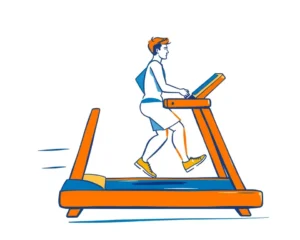As winter approaches and the days grow shorter, many individuals experience a dip in their mood and energy levels. This isn’t just a case of the “winter blues”; it could be Seasonal Affective Disorder (SAD), a type of depression linked to the changing seasons. While light therapy and medication are common treatments, incorporating a consistent exercise routine can be a powerful, natural way to combat SAD and improve your overall well-being.
Understanding Seasonal Affective Disorder
Seasonal Affective Disorder is a type of depression that occurs at the same time each year, most commonly starting in the fall and continuing through the winter months. Reduced sunlight exposure during these months can disrupt the body’s internal clock (circadian rhythm) and lead to a drop in serotonin and dopamine levels, neurotransmitters that regulate mood, sleep, and appetite.
Symptoms of SAD can include:
- Persistent feelings of sadness or hopelessness
- Fatigue and low energy
- Oversleeping
- Changes in appetite, often with cravings for carbohydrates
- Weight gain
- Irritability
- Difficulty concentrating
- Withdrawal from social activities
It’s important to note that SAD is more than just feeling a bit down during the winter. It can significantly impact daily life, affecting work, relationships, and overall quality of life. If you suspect you have SAD, consulting a healthcare professional is crucial for proper diagnosis and treatment.
The Exercise Rx: How Physical Activity Fights SAD
Exercise is increasingly recognized as a valuable tool in managing and alleviating SAD symptoms. Regular physical activity offers a multitude of benefits that directly address the underlying causes and symptoms of this seasonal form of depression.
The Science Behind Exercise and Mood
- Endorphin Release: Exercise stimulates the release of endorphins, which act as natural mood boosters and pain relievers. These “feel-good” hormones can help counter feelings of sadness and anxiety associated with SAD.
- Neurotransmitter Regulation: Physical activity can increase the production and regulation of serotonin and dopamine, two key neurotransmitters that play a vital role in mood regulation. By boosting these neurotransmitters, exercise can help stabilize mood and promote a sense of well-being.
- Improved Sleep: SAD can disrupt sleep patterns, leading to fatigue and low energy. Regular exercise can improve sleep quality by regulating circadian rhythms and reducing stress and anxiety. However, avoid vigorous exercise close to bedtime, as it can interfere with sleep.
- Circadian Rhythm Regulation: Exposure to natural light, especially during morning workouts, helps reset the body’s internal clock, improving sleep-wake cycles and reducing the impact of reduced sunlight during winter.
- Increased Energy Levels: While it may seem counterintuitive when feeling fatigued, exercise can actually increase energy levels. Physical activity improves cardiovascular health, enhances blood flow, and delivers more oxygen and nutrients to tissues, combating the fatigue often associated with SAD.
- Stress Reduction: Exercise can be a great way to manage stress, a contributing factor to SAD. Engaging in physical activity helps lower levels of stress hormones like cortisol, promoting relaxation and mental clarity.
- Enhanced Self-Esteem: Achieving fitness goals and feeling physically stronger can boost self-esteem and confidence, counteracting feelings of worthlessness that can accompany SAD.
- Social Interaction: Exercising with a friend or in a group setting provides social interaction, combating feelings of isolation and loneliness that can worsen SAD symptoms.
Types of Exercises for SAD Relief
While any form of exercise can be beneficial, certain types may be particularly effective in alleviating SAD symptoms:
- Aerobic Exercise: Activities like brisk walking, jogging, swimming, cycling, and dancing elevate heart rate, boost endorphin levels, and improve mood. Aim for at least 30 minutes of moderate-intensity aerobic exercise most days of the week.
- Strength Training: Lifting weights or using resistance bands can build muscle strength and improve overall mood. Strength training has been linked to increased levels of serotonin and dopamine in the brain. Incorporate strength training exercises into your routine two to three times a week.
- Mind-Body Exercises: Practices like yoga, tai chi, and meditation can reduce stress, improve mental clarity, and promote relaxation. Yoga, in particular, combines physical movement with mindfulness and breathing exercises, which can help calm the mind and alleviate symptoms of anxiety or depression.
- Outdoor Activities: Hiking, skiing, snowshoeing, and even a simple walk in the park can be incredibly beneficial, especially when done during daylight hours. Exposure to natural light helps regulate circadian rhythms and boost vitamin D levels, which can be low during winter months.
Creating an Effective Exercise Routine
- Start Slowly: If you’re new to exercise, begin with short, low-intensity activities and gradually increase the duration and intensity as you get fitter.
- Find Activities You Enjoy: Choose activities that you find enjoyable and motivating. This will make it more likely that you’ll stick with your exercise routine.
- Set Realistic Goals: Set achievable goals to avoid discouragement. Celebrate your progress along the way.
- Make it a Routine: Schedule exercise into your day like any other important appointment. Consistency is key to seeing results.
- Exercise Outdoors When Possible: Take advantage of daylight hours to exercise outdoors. Even a short walk during your lunch break can make a difference.
- Find a Workout Buddy: Exercising with a friend can provide motivation and accountability.
- Listen to Your Body: Rest when you need to and don’t push yourself too hard, especially when you’re first starting out.
- Be Patient: It may take a few weeks to notice the benefits of exercise on your mood and energy levels. Don’t get discouraged if you don’t see results immediately.
Maximizing the Benefits: Timing and Environment
- Morning Exercise: Exercising in the morning, especially outdoors, can be particularly beneficial for regulating circadian rhythms and increasing alertness throughout the day.
- Sunlight Exposure: Whenever possible, exercise outdoors during daylight hours to maximize exposure to natural light.
- Bright Indoor Environment: If you’re exercising indoors, make sure the environment is well-lit and airy.
- Combine with Light Therapy: Exercise can be even more effective when combined with other SAD treatments, such as light therapy.
Beyond Exercise: Additional Strategies for Combating SAD
While exercise is a powerful tool, it’s important to consider other strategies for managing SAD:
- Light Therapy: Using a light therapy box that emits bright light can help compensate for the lack of natural sunlight during winter.
- Vitamin D Supplementation: Vitamin D deficiency is common during winter months, and studies have linked low levels of vitamin D to depression. Talk to your doctor about whether vitamin D supplementation is right for you.
- Healthy Diet: Eating a balanced diet rich in fruits, vegetables, and whole grains can improve mood and energy levels. Be mindful of carbohydrate cravings, which can lead to weight gain.
- Stress Management Techniques: Practicing relaxation techniques like meditation, deep breathing, and yoga can help manage stress and anxiety.
- Social Support: Connecting with friends and family can combat feelings of isolation and loneliness.
- Cognitive Behavioral Therapy (CBT): CBT is a type of therapy that helps people identify and change negative thought patterns and behaviors. It can be an effective treatment for SAD.
- Medication: In some cases, antidepressant medication may be necessary to manage SAD symptoms. Talk to your doctor to determine if medication is right for you.
Conclusion: Move Your Way to a Brighter Winter
Seasonal Affective Disorder can be a challenging condition, but it is manageable. By incorporating a consistent exercise routine into your daily life, you can harness the power of physical activity to boost your mood, increase your energy levels, and improve your overall well-being. Remember to combine exercise with other healthy habits and seek professional help if needed. This winter, take control of your mental health and move your way to a brighter, happier season.







